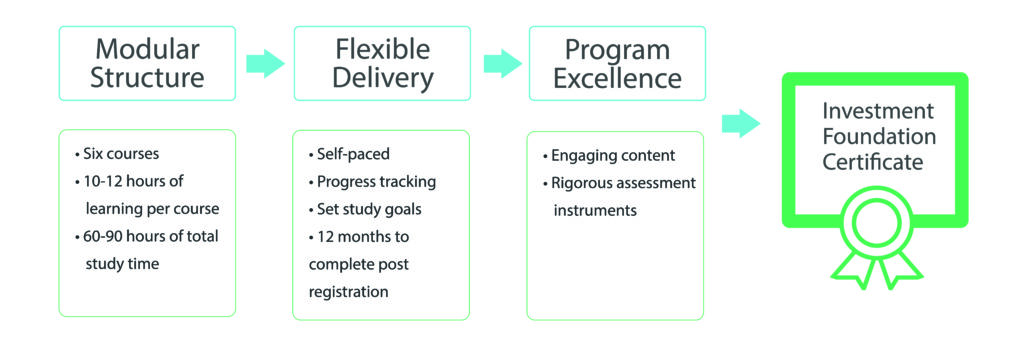Investment Foundations® Certificate
글로벌 금융 비전문가를 위한
투자 기초 자격증

What is the Investment Foundations Certificate?
CFA Institute의 Investment Foundations Certificate(투자 기초 자격증 또는 IFC)는 글로벌 투자 산업에 대한 명확한 이해를 돕는 자기학습형 온라인 자격 시험으로 투자 부서와 함께 근무하는 마케팅, 커뮤니케이션, 영업, 인사, IT, 법률 및 컴플라이언스 등 비전문가를 위한 글로벌 자격증 프로그램입니다.
Why Earn the Investment Foundations Certificate?
- 투자 산업 전반에 대한 이해를 높일 수 있어 업무 역량을 향상 시킬 수 있음
- 차별화된 역량 강화를 통해 투자 부서 동료들과 더욱 자신감 있게 소통하고 협업이 가능함
- 취업에 있어 우위를 점 할 수 있으며 투자 분야의 채용 기회가 높아짐
- 투자 산업에 대한 이해도가 높아져 적절한 질문을 던지고 혁신을 이룰 수 있음
- 투자 분야에서 귀하에 맞는 더 큰 그림을 그릴 수 있음
How to earn the certificate

Human Resource

Information Technology

Project Management

Marketing

Legal

Administration

Strategy

Operations
Investment Foundations – Topic Covered
Industry Overview and Structure
- Types of organiztions
- Industry roles and responsibilities
- Key industry forces w/ Fintech
- Objectives, roles, and types of regulation
- and mores…
Industry Overview and Structure
- Types of organiztions
- Industry roles and responsibilities
- Key industry forces w/ Fintech
- Objectives, roles, and types of regulation
- and mores…
Industry Overview and Structure
- Types of organiztions
- Industry roles and responsibilities
- Key industry forces w/ Fintech
- Objectives, roles, and types of regulation
- and mores…
Industry Overview and Structure
- Types of organiztions
- Industry roles and responsibilities
- Key industry forces w/ Fintech
- Objectives, roles, and types of regulation
- and mores…
Industry Overview and Structure
- Types of organiztions
- Industry roles and responsibilities
- Key industry forces w/ Fintech
- Objectives, roles, and types of regulation
- and mores…
Industry Overview and Structure
- Types of organiztions
- Industry roles and responsibilities
- Key industry forces w/ Fintech
- Objectives, roles, and types of regulation
- and mores…

How It Works
평가와 활동이 포함된 6개 코스의 과정을 수강한 후 최종 평가를 합격하게 되면, Investment Foundations Certificate(디지털 자격증)을 받게 되며, Linkedin등에 활용할 수 있는 디지털 뱃지를 받게 됩니다.
Modular Structure
- 총 6개 코스(코스당 3-5개 모듈)
- 총 60-90 학습 시간(코스당 10-12시간)
- 프로그램 등록비 USD 350 (6개 코스 및 시험 응시료 포함)
- 재시험 응시료 USD 270
Flexible Delivery
- 자기주도 학습
- 학습 사항 트래킹
- 학습 목표 설정
- 이수 기간: 12개월 이내
Program Excellence
- 흥미로운 콘텐츠
- 온라인, 100문항 객관식 시험(140분)
- 성공적인 이수시 디지털 자격증 발급
학습 과정 국문 안내 ( 단, 시험을 포함 한 모든 과정은 영어로 진행)
Course 1: 산업 개요 및 구조
Module 1) 투자 산업 개요
- Lesson 1: 금융 서비스 산업이란
- Lesson 2: 투자 산업과 경제적 이익
- Lesson 3: 투자 산업과 투자자 이익
- Lesson 4: 투자 산업 참여자
Module 2) 투자 산업 구조
- Lesson 1: 투자회사 구조
- Lesson 2: 투자회사 구성원과 리더십
- Lesson 3: 금융 기관
Module 3) 산업내 서비스 소개
- Lesson 1: 투자 관리 서비스
- Lesson 2: 투자 정보 서비스
- Lesson 3: 트레이딩(매매) 서비스
Module 4) 재무 설계 서비스 및 핀테크 소개
- Lesson 1: 투자산업 관련 서비스의 필요성
- Lesson 2: 재무 설계 서비스
- Lesson 3: 핀테크 소개
- Lesson 4: 핀테크 어플리케이션
Module 5) 투자 전문성과 규제
- Lesson 1: 투자 산업을 주도하는 주요 요소
- Lesson 2: 윤리와 투자 산업
- Lesson 3: 금융 산업 규제
- Lesson 4: 규제의 목적
- Lesson 5: 규제 유형
- Lesson 6: 컴플라이언스 위반 결과
Course 2: 증권시장의 유형과 기능
Module 1) 유가증권 시장과 거래 유형
- Lesson 1: 발행 시장과 유통 시장
- Lesson 2: 발행자의 역할
- Lesson 3: 발행시장에서의 거래
- Lesson 4: 거래소
- Lesson 5: 시장 구조
Module 2) 탈중앙화 금융의 주문 프로세스 및 기회
- Lesson 1: 포지션
- Lesson 2: 주문
- Lesson 3: 청산과 정산
- Lesson 4: 거래 비용
- Lesson 5: 탈중앙화 금융(DeFi)이란?
Module 3) 투자 수단: 집합투자, ETF, 유가증권시장 지수
- Lesson 1: 직접 및 간접 투자
- Lesson 2: 집합투자
- Lesson 3: 유가증권시장 지수
- Lesson 4: 인덱스 펀드
Module 4) 투자수단: 헤지펀드, 재간접투자펀드, 관리계정
- Lesson 1: 헤지펀드
- Lesson 2: 재간접투자펀드
- Lesson 3: 관리계정
Course 3: 투자 방법
Module 1) 양적 개념
- Lesson 1: 화폐의 시간 가치
- Lesson 2: 현재 가치와 미래 가치
- Lesson 3: 순 현재 가치
- Lesson 4: 화폐의 시간 가치 적용
- Lesson 5: 기술 통계학
- Lesson 6: 분산도
- Lesson 7: 정규 분포
- Lesson 8: 상관관계
Module 2) 투자 상품과 지분증권(주식형 유가증권) 소개
- Lesson 1: 투자 상품 소개
- Lesson 2: 지분증권 소개
- Lesson 3: 보통주의 가치 평가
- Lesson 4: 지분 증권 투자 위험
- Lesson 5: 기업 행동
Module 3) 채무증권(부채형 유가증권)
- Lesson 1: 채권 소개
- Lesson 2: 채무변제순위
- Lesson 3: 채권 유형
- Lesson 4: 내재된 조항이 있는 채권
- Lesson 5: 채권 가치 평가
- Lesson 6: 채권 투자 위험
- Lesson 7: 수익률 곡선
- Lesson 8: 지분증권(주식)과 채무증권(채권)의 비교
Module 4) 파생상품
- Lesson 1: 파생계약 소개
- Lesson 2: 파생계약의 용도
- Lesson 3: 파생계약 주요 조건
- Lesson 4: 선도와 선물
- Lesson 5: 옵션
- Lesson 6: 스왑
Module 5) 대체투자
- Lesson 1: 대체투자의 장점과 제한
- Lesson 2: 프라이빗에퀴티 투자
- Lesson 3: 부동산 투자
- Lesson 4: 상품 투자
Course 4: 투자 입력 및 도구
Module 1) 미시경제학
- Lesson 1: 경제학과 미시경제학 소개
- Lesson 2: 수요와 공급
- Lesson 3: 시장 균형
- Lesson 4: 수요 탄력성
- Lesson 5: 생산 수익과 비용
- Lesson 6: 시장 환경
Module 2) 거시경제학
- Lesson 1: 거시경제학 소개
- Lesson 2: 국내총생산과 경기순환
- Lesson 3: 경제 성장
- Lesson 4: 경기 순환
- Lesson 5: 경제 지표
- Lesson 6: 인플레이션
- Lesson 7: 통화 정책과 재정 정책
Module 3) 국제무역 경제
- Lesson 1: 수입 및 수출
- Lesson 2: 국가 간 비교 우위
- Lesson 3: 국제수지
- Lesson 4: 환율제도
- Lesson 5: 통화가치
- Lesson 6: 외환시장
Module 4) 재무제표
- Lesson 1: 재무보고의 역할
- Lesson 2: 대차대조표
- Lesson 3: 손익계산서
- Lesson 4: 현금흐름표
- Lesson 5: 재무제표 연결
- Lesson 6: 재무제표 분석
Course 5: 고객 니즈에 대한 응대
Module 1) 투자자와 투자자의 니즈
- Lesson 1: 투자자 유형과 특징
- Lesson 2: 투자자의 니즈에 영향을 미치는 요소
- Lesson 3: 투자 지침서
Module 2) 투자 관리
- Lesson 1: 위험과 포트폴리오 분산
- Lesson 2: 자산배분과 포트폴리오 구성
- Lesson 3: 패시브 투자와 액티브 투자
- Lesson 4: 시장의 비효율성
Module 3) 위험 관리
- Lesson 1: 위험의 정의 및 구분
- Lesson 2: 위험 관리 프로세스
- Lesson 3: 위험 관리 기능
- Lesson 4: 운영 위험
- Lesson 5: 컴플라이언스 위험
- Lesson 6: 투자 위험
- Lesson 7: Value at Risk (VaR)
Module 4) 성과 평가
- Lesson 1: 성과 평가 프로세스
- Lesson 2: 수익률 측정
- Lesson 3: 벤치마크
- Lesson 4: 위험 측정
- Lesson 5: 상대적 성과 측정
- Lesson 6: 알파
- Lesson 7: 성과기여도
Course 6: 공공의 이익을 위한 노력
Module 1) 환경, 사회 및 지배구조 (ESG) 투자
- Lesson 1: 책임 투자 접근 방법
- Lesson 2: ESG 투자의 요소
- Lesson 3: ESG 실천에 따른 유익과 관련 과제
- Lesson 4: 투자자 관여(인게이지먼트)와 스튜어드십
Module 2) 다양성, 공정성, 포용성 (DEI) 실천
- Lesson 1: DEI의 주요 개념
- Lesson 2: 편향 인식과 완화
- Lesson 3: DEI의 모범 사례 및 성공 지표
- Lesson 4: 직장에서 DEI 개념 적용
Module 3) Part1: 전문성
- Lesson 1: 신탁과 이해관계자 의무
- Lesson 2: 윤리와 전문가 행동 규범
Module 3) Part 2: 윤리적 의사결정 프레임워크
- Lesson 1: 윤리적 행동의 결과 vs 비윤리적 행동의 결과
- Lesson 2: 윤리적 의사결정 프레임워크

